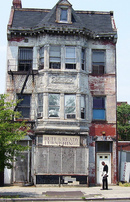Book review: Capital Losses

Photo by DreamCity4IFE on Flickr.
Not long after witnessing the demolition of the Hitt House at 1501 New Hampshire Avenue off Dupont Circle in 1970, local historian James Goode began working on Capital Losses: A Cultural History of Washington’s Destroyed Buildings. The book remains a definitive work for both emerging and established city preservationists.
Goode began his research in December of 1973, looking over more than one million photographs in 225 public and private collections. The former curator of the Smithsonian Castle and current archivist and historian for the BF Saul Company published the first edition of Capital Losses with the Smithsonian Institution Press in 1979.
“In DC in the 50s, 60s, and 70s people looked at Victorian architecture as something that should be removed,” says Goode, who observes there is a greater awareness and appreciation today of historic architecture which “adds charm and character to a neighborhood.”
More than a strict architectural history, Capital Losses provides insight into the intimate history of each building and landmark, and how its presence contributed to the livability of the city.
The construction of new commercial buildings and residential properties throughout downtown and mid-city over the past decade has altered the cityscape, but has not fundamentally obscured the city’s historic Victorian heritage.
Enacted in 1978, the District of Columbia’s Historic Landmark and Historic District Preservation Act is regarded as one of the strongest preservation laws in the country. Goode notes that this legislation, along with the maturation of the non-profit DC Preservation League and the city’s Historic Preservation Review Board, provides the DC with a well-entrenched preservation community.
”Capital Losses has certainly helped get a number of historic districts established in the city,” says Goode. To date, the Office of Planning recognizes 46 distinct historic neighborhoods and districts.
Last updated in 2003, Capital Losses focuses on both residential and non-residential property that has since been lost to only archival records.
From the old Washington Jail (built in 1839 and razed in 1874) at 4th and G Street NW, and the Center Market (designed by Adolf Cluss in 1871 and razed in 1931) at 7th and Pennsylvania Avenue NW, where the National Archives currently stands, to horse troughs that were at major intersections throughout the city until the mid 1950s, Capital Losses chronicles historic Washington with more than 250 entries.
Goode cites “government expansion, private real estate development, urban renewal, freeways, commercial growth, and the enlargement of institutions such as universities, hospitals, and churches” as factors that contributed to Washington losing a “large number of architecturally significant buildings, ranging from Federal structures of the 1790s to art moderne landmarks from the 1930s” since the end of World War II.
Goode, who is also the author of Washington Sculpture: A Cultural History of Outdoor Sculpture in the Nation’s Capital and Best Addresses is working on a new book, expected out in 3 years, about DC’s historic houses.
“Dedicated to those Washingtonians who continue to fight to save the architectural heritage of the nation’s capital,” Capital Losses, more than three decades after its initial publication, remains necessary reading for anyone who cares or wants to learn about preservation in 21st century Washington.
A version of this article was first published by Capital Community News.
